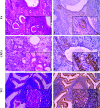Pathogenesis Analysis of Salivary Gland Tumors Through the Expression of Programmed Death-Ligand 1 (PD-L1)
- PMID: 37974781
- PMCID: PMC10645909
- DOI: 10.1007/s12070-023-03906-y
Pathogenesis Analysis of Salivary Gland Tumors Through the Expression of Programmed Death-Ligand 1 (PD-L1)
Abstract
Pleomorphic adenoma (PA) is the most common salivary gland neoplasm, followed by Warthin's tumor (WT). In addition to its high frequency, PA also shows metastasis and transformation towards malignancy as carcinoma ex-pleomorphic adenoma (CXPA). While the histogenesis of WT remains unclear, especially given the presence of lymphoid stroma around the developing tumor and the immunological interaction between them. Immune escape is a carcinogenesis mechanism of tumors to avoid the host immune system by producing PD-L1. This study was conducted to determine whether there is an immune escape through the expression of PD-L1 in salivary gland tumors. The tissue sections of PA, CXPA, and WT were stained with Hematoxylin Eosin and immunostained with a rabbit monoclonal recombinant anti-PD-L1 antibody. We observed immunopositive PD-L1 on the cell membrane with or without cytoplasm staining. PA and CXPA expressed PD-L1, accompanied by an anomaly expression of CXPA in several spots at the salivary gland at the surgical border. Therefore, PD-L1 is one of the PA pathways to transform into CXPA through immune escape. WT expressed PD-L1 in the cytoplasm and lymphoid stroma but not on the cell membrane. It is interpreted as positive constitutive, which may have the function of increasing tumor cell growth, while overexpressed PD-L1 in lymphoid stroma is thought to be associated with a poor prognosis of the tumor and is suspected to transform into malignancy, such as B-cell Lymphoma.
Keywords: Carcinoma ex pleomorphic adenoma; Immune escape; PD-L1; Pleomorphic adenoma; Salivary gland tumors; Warthin’s tumor.
© Association of Otolaryngologists of India 2023. Springer Nature or its licensor (e.g. a society or other partner) holds exclusive rights to this article under a publishing agreement with the author(s) or other rightsholder(s); author self-archiving of the accepted manuscript version of this article is solely governed by the terms of such publishing agreement and applicable law.
Conflict of interest statement
Conflict of interestThe authors declare that they have no conflict of interest.
Figures
Similar articles
-
An immunohistochemical study of XIAP expression in pleomorphic adenoma and carcinoma ex pleomorphic adenoma.J Oral Pathol Med. 2008 Nov;37(10):634-8. doi: 10.1111/j.1600-0714.2008.00680.x. Epub 2008 Jul 29. J Oral Pathol Med. 2008. PMID: 18673415
-
Heterogeneity and versatility of the extracellular matrix during the transition from pleomorphic adenoma to carcinoma ex pleomorphic adenoma: cumulative findings from basic research and new insights.Front Oral Health. 2023 Apr 17;4:942604. doi: 10.3389/froh.2023.942604. eCollection 2023. Front Oral Health. 2023. PMID: 37138857 Free PMC article. Review.
-
[Carcinoma ex pleomorphic adenoma of major salivary glands--a clinicopathologic review].Otolaryngol Pol. 2007;61(5):687-93. doi: 10.1016/S0030-6657(07)70507-3. Otolaryngol Pol. 2007. PMID: 18552001 Polish.
-
CD44 expression in pleomorphic adenoma, carcinoma ex pleomorphic adenoma and their adjacent normal salivary glands.Dent Res J (Isfahan). 2018 Sep-Oct;15(5):361-366. Dent Res J (Isfahan). 2018. PMID: 30233657 Free PMC article.
-
Low Grade Carcinoma Ex-Pleomorphic Adenoma: Diagnosis and Diagnostic Challenges Caused by Fine Needle Aspiration: Report of Three Cases and Review of Literature.Head Neck Pathol. 2018 Mar;12(1):82-88. doi: 10.1007/s12105-017-0829-7. Epub 2017 Jun 6. Head Neck Pathol. 2018. PMID: 28589437 Free PMC article. Review.
References
-
- Kumar V, Abbas AK, Aster JC. Robbins basic pathology. 10. Amsterdam: Elseiver Inc; 2018.
LinkOut - more resources
Full Text Sources
Research Materials

